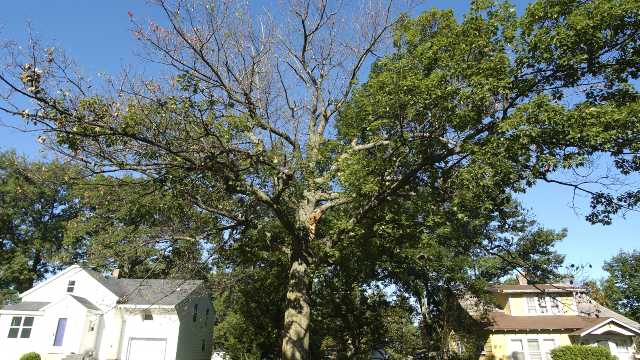Early leaf drop and mottled green and brown leaves are signs of oak wilt disease affecting trees. To prevent the spread of this harmful condition, it’s crucial to take action and keep oak trees healthy.
Between April 15 and July 15, beetles actively transport fungus spores from one tree to another, making oak trees highly susceptible to oak wilt infection. The disease targets oak trees with bark wounds, leading to the rapid weakening of white oaks and the eventual death of red oaks within weeks.
Simeon Wright, a forest health specialist in the DNR’s Forest Resources Division, advises against pruning oak trees during the high-risk period of April 15 to July 15. Adhering to these pruning guidelines helps prevent the spread of infection. Once a tree is infected, there is no cure, and without expensive treatments, the disease can spread to nearby trees, potentially decimating the entire oak population in the area.
If you have an oak tree that sustains damage during the high-risk period, it’s important to promptly cover any wounds with tree-wound paint or latex-based paint. However, painting wounds on other tree species is not recommended as it may hinder the healing process.
Apart from being carried by the nitidulid beetle, which is active in spring and early summer, oak wilt can also spread through grafted roots, as well as through spores carried by moving infected firewood. To prevent further transmission, it is vital not to move firewood from one location to another, especially if it originates from infected trees. If you suspect your firewood may be infected, you can slow the spread by burning, chipping, or debarking it before April. Once the firewood has been seasoned for over a year and the bark has loosened, it no longer poses a risk of spreading oak wilt.
Oak wilt was first identified in the Midwest during the 1940s and confirmed in Michigan in the early 1950s. It has since become common in the Lower Peninsula and has been identified in Menominee, Dickinson, and Iron counties in the Upper Peninsula. The disease primarily affects trees in the red oak family, including black oak, northern red oak, and northern pin oak, which have pointed leaf tips. On the other hand, trees in the white oak group, such as white oak, swamp white oak, and bur oak, have rounded leaf edges and are better equipped to prevent rapid spread of the disease throughout the entire tree, reducing the risk of extensive damage.
Symptoms of oak wilt typically manifest between late June and September. Affected trees rapidly wilt from the top down, shedding leaves that may be green, brown, or a combination of both colors. If left untreated, oak wilt spreads through grafted root systems, causing more red oaks to perish as they grow in close proximity. As the disease progresses, more fungal spores are produced, facilitating beetle-mediated transmission to new locations.
To mitigate the risk of oak wilt infection resulting from logging damage, the DNR imposes restrictions on cutting red oak trees on state land between April 15 and July 15. Private forest landowners are advised to exercise caution during this period and, whenever possible, postpone harvests in oak forests until after July 15 to minimize the chances of infection.







